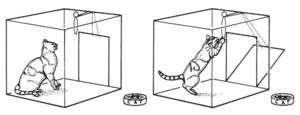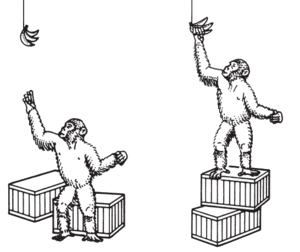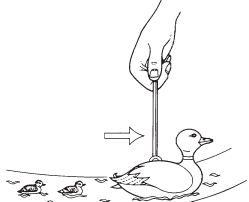An animal’s survival prospects are greatly improved if the animal alters its behaviour according to its experience. Learning increases its chances of obtaining food, avoiding predators, and adjusting to other often unpredictable changes in its environment. The importance of learning in the development of behaviour was stressed particularly by US experimental psychologists, such as John B. Watson (1878–1958) and B. F. Skinner (1904–90), who studied animals under carefully controlled laboratory conditions. They demonstrated how rats and pigeons could be trained, or ‘conditioned’, by exposing them to stimuli in the form of food rewards or electric shocks. This work was criticized by others, notably the ethologists, who preferred to observe animals in their natural surroundings and who stressed the importance of inborn mechanisms, such as instinct, in behavioural development. A synthesis between these two once-conflicting approaches has now been achieved: learning is regarded as a vital aspect of an animal’s development, occurring in response to stimuli in the animal’s environment but within constraints set by the animal’s genes. Hence young animals are receptive to a wide range of stimuli but are genetically predisposed to respond to those that are most significant, such as those from their mother.
Conditioning
The classical demonstration of conditioning was undertaken by Ivan Pavlov in the early 1900s. He showed how dogs could learn to associate the ringing of a bell with the presentation of food, and after a while would salivate at the sound of the bell alone. He measured the amount of saliva produced by a dog, and showed that this increased as the animal learnt to associate the sound of the bell with presentation of food. The dog became conditioned to respond to the sound of the bell.
Such learning is widespread among animals. Pavlov’s experiment involved positive conditioning, but negative conditioning can also occur. For example, a young bird quickly learns to associate the black-and-orange markings of the cinnabar moth’s caterpillars with their unpleasant taste, and to avoid eating such caterpillars in future.
Trial-and-error learning
This occurs when the spontaneous behaviour of an animal accidentally produces a reward. For example, a hungry cat is placed in a box and required to pull on a string loop to open the door and gain access to food (see illustration). After various scratching and reaching movements, it accidentally pulls the loop and is released from the box. Its behaviour is instrumental in securing a reward. On subsequent occasions, the cat’s attention becomes increasingly focused on the loop, until eventually it pulls the loop straightaway on entering the box.

Trial and error learning by a cat
Insight learning: problem solving
Chimpanzees can learn to stack crates or boxes to form a platform or to manipulate poles in order to reach an otherwise inaccessible bunch of bananas. A chimp may apparently solve such a problem suddenly, as if gaining insight after mental consideration of the problem. Such complex learning benefits from previous experience, in this instance by simply ‘playing’ with crates, boxes, or poles.

Insight learning by a chimpanzee
Imprinting
This is a form of learning found in young animals, especially young birds, in which they form an attachment to their mother in early life, thereby ensuring that they are taken care of and do not wander off. For example, chicks or ducklings follow the first large moving object that they encounter after hatching. This is normally their mother, but artificially incubated youngsters can become imprinted on a wooden decoy, as illustrated here, or even on a human being – as originally demonstrated in goslings and ducklings by Konrad Lorenz Imprinting occurs during a particularly sensitive period of development: the attachment formed by an animal to an imprinted individual or object lasts well into its adult life.

Imprinting in ducklings
- evil genie
- evil, problem of
- evil twin
- EVN
- evocation
- evo-devo
- evolute
- evolution
- evolutionary economic geography
- evolutionary ethics
- evolutionary lineage
- evolutionary programming
- evolutionary psychology
- evolutionary rate
- evolutionary species
- evolutionary theory of the firm
- evolutionary tree
- evolutionary trend
- evolutionary zone
- evolutionism
- Evolved Laser Interferometer Space Antenna
- evolved magma
- evolved star
- EVS
- E wave